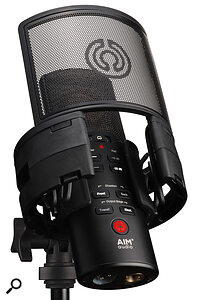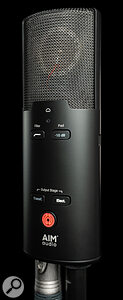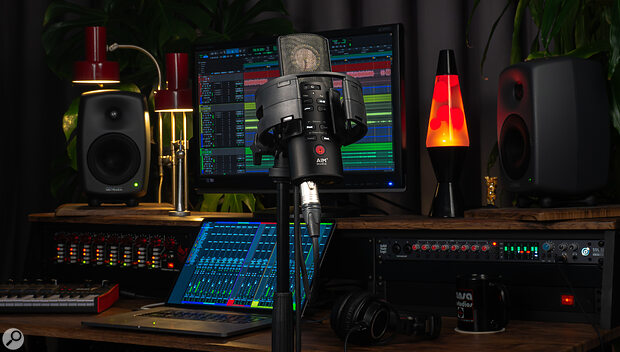A new German manufacturer takes aim at the mic market, promising real innovation.
Berlin is, arguably, the spiritual home of the capacitor microphone. Although the first commercial models were made in the USA by Western Electric, it was German researchers and manufacturers who developed the “condenser mic” as we know it today, and German companies such as Neumann, Microtech Gefell, Sennheiser and Schoeps are still household names. (Well, they are in my house.) Yet although Neumann’s head office is still in Berlin, their factory was moved to Wedemark, near Hannover, in the early ’90s, and there has been no microphone manufacture on a large scale in the German capital for the last three decades — until now.
Aim Audio are a new company whose stated mission is to bring back volume mic manufacturing to Berlin. That in itself is a lofty ambition, but it’s not the only bold move that Aim are making. Rather than selling clones or copies of classic German models, they are intent on demonstrating that the capacitor mic is not yet a mature technology. Their debut products thus display a wealth of innovation, including some patented new developments.
Straight Outta Berlin
Aim Audio are entering the market with two microphones: the flagship multi‑pattern Inspire, and a more affordable fixed‑cardioid derivative called the Essence. Both incorporate a number of novel features, and the focus on innovation is also apparent in accessories such as the Orbit shockmount and the Sentry pop filter. In fact, a fairly large part of the price differential between the two models is accounted for by the fact that the Inspire is available only as part of the Inspire+ Pack, which includes the Orbit, the Sentry and a good‑quality Peli‑style hard plastic case. By contrast, the Essence comes with no accessories to speak of, though the Orbit can be bought separately.
 Aim Audio’s custom Sentry pop filter attaches magnetically to the Orbit shockmount.This could be more significant than you’d expect, because both mics share a distinctive form factor that isn’t compatible with many third‑party shockmounts. In cross‑section, the body is a flattened ellipse that is too wide to fit easily into something like a Rycote InVision mount. So, unless you buy the Orbit separately, the only way to attach the Essence to a mic stand is to do so directly, using the threaded socket adjacent to the XLR connector on the base of the mic.
Aim Audio’s custom Sentry pop filter attaches magnetically to the Orbit shockmount.This could be more significant than you’d expect, because both mics share a distinctive form factor that isn’t compatible with many third‑party shockmounts. In cross‑section, the body is a flattened ellipse that is too wide to fit easily into something like a Rycote InVision mount. So, unless you buy the Orbit separately, the only way to attach the Essence to a mic stand is to do so directly, using the threaded socket adjacent to the XLR connector on the base of the mic.
The Aim mics’ unusual dimensions aren’t just for show: they provide a large and relatively flat area at the front of the mic, which is fully exploited in the design of the Inspire. Following the lead of some AKG C414 variants, most settings on the Inspire and Essence are configured using buttons that light up to indicate their status. The one exception is the polar pattern on the Inspire, which is chosen using a five‑position thumbwheel. This is a sensible decision, to my mind, because it means you can see what pattern is selected without having to plug the mic in.
The upper group of four buttons on the Inspire engage features that are familiar from other mics: ‑10 or ‑20 dB pad settings, and a choice of two high‑pass filters. One is a steep rumble filter turning over at 80Hz, while the other is designed to offset the proximity effect, with a gentler slope and a higher corner frequency. The Essence is simpler, with just one pad and one filter option.
Back To Front
At the bottom of both the Inspire and Essence you’ll find a button bearing a logo that slightly resembles a human brain. This illuminates red when phantom power is applied, and is used to set the brightness of the LEDs; it’s also possible to turn them off completely if you so desire. But the really interesting controls are those located in the group above this. On the Inspire, this includes buttons labelled Front and Back, which flip the polar pattern by 180 degrees if you are in subcardioid, cardioid or hypercardioid mode. I was initially sceptical about how useful this would be, and then I remembered all the times I’ve had to remove mics from their mounts and put them back the other way around to get them pointing where I wanted! It also means that you can keep the controls visible and accessible when close miking something like a guitar cabinet.
 The more affordable, cardioid‑only Essence retains the switchable output stage that is Aim Audio’s hallmark.The patented pièce de resistance of Aim’s design, however, is found in both the Inspire and the Essence, and is toggled using buttons labelled Transf and Elec. These switch between an old‑school, transformer‑balanced output stage and a modern transformerless electronically balanced circuit, whilst keeping the output level from the mic the same. And Aim haven’t used any old off‑the‑shelf transformer: they’ve developed their own custom toroidal design with a “nanocrystalline Vitroperm core”. That sounds like something out of Star Trek, but the toroidal shape does have advantages over the more usual rectangular...
The more affordable, cardioid‑only Essence retains the switchable output stage that is Aim Audio’s hallmark.The patented pièce de resistance of Aim’s design, however, is found in both the Inspire and the Essence, and is toggled using buttons labelled Transf and Elec. These switch between an old‑school, transformer‑balanced output stage and a modern transformerless electronically balanced circuit, whilst keeping the output level from the mic the same. And Aim haven’t used any old off‑the‑shelf transformer: they’ve developed their own custom toroidal design with a “nanocrystalline Vitroperm core”. That sounds like something out of Star Trek, but the toroidal shape does have advantages over the more usual rectangular...
You are reading one of the locked Subscribers-only articles from our latest 5 issues.
You've read 30% of this article for FREE, so to continue reading...
- ✅ Log in - if you have a Digital Subscription you bought from SoundOnSound.com
- ⬇️ Buy & Download this Single Article in PDF format £0.83 GBP$1.49 USD
For less than the price of a coffee, buy now and immediately download to your computer, tablet or mobile. - ⬇️ ⬇️ ⬇️ Buy & Download the FULL ISSUE PDF
Our 'full SOS magazine' for smartphone/tablet/computer. More info... - 📲 Buy a DIGITAL subscription (or 📖 📲 Print + Digital sub)
Instantly unlock ALL Premium web articles! We often release online-only content.
Visit our ShopStore.

